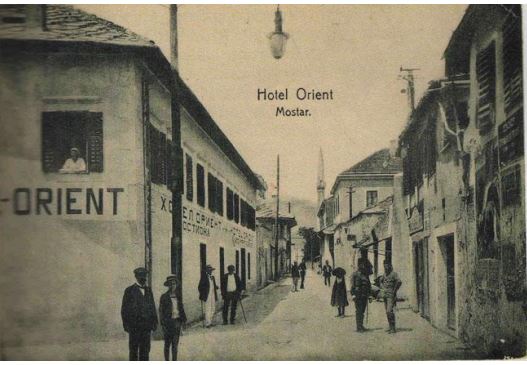
brochure "Partizanski spomenik u Mostaru" (1980)
book “Spomenica Mostara 1941-1945.”
another document or proof of the memorial stone (e.g., a photograph).
Zajko Š. MEHIĆ
ZAJIM ZAJKO MEHIĆ, son of OMER and HAIŠA née Beklija, born on May 12, 1895,* in Mostar. He was the owner of a han (inn). A merchant, married, and father of three children. He actively assisted the National Liberation Movement. He was arrested by the Ustaše at the end of 1944, taken to the Stara Gradiška camp, and killed. According to a Ustaše source, he was “sent to the camp for a period of 2 years upon the proposal of the Ž.R.O. in Mostar; he was a member of the local committee in Mostar and supported the partisans with food and money.”
An example from literature shows how selflessly Zajko helped exhausted fighters returning from the Sutjeska:
“After resting and discussing the next steps, the group decided that the people from Mostar would go to Mostar, and the others to Konjic and Prozor. In Dobrče, they were welcomed by the families of Đuliman, Ćorić, and Smajkić, who provided them with meager food, as they themselves had nothing to eat. Once again, Ibro Ćorić set off for Mostar, who knows for how many times, and from Zajko Mehić, he brought back a horse loaded with flour, beans, dried meat, and dried plums. Meha Arap and Živko Papo Henći joined the group, who arrived, breaking through from Sutjeska, just like Ibro with valuable supplies. They eagerly took on the cooking duties and prepared delicious meals. Within a few days of staying in Dobrče, contact was established with the organization in the city, and the comrades descended to Mostar (…)”
Omer Šaput, the brother of the murdered Safet Šaput, gave a statement after the war on October 19, 1945, which was published as the “Report of the City Commission for Investigating War Crimes of the Occupiers and their Collaborators” regarding Safet’s arrest, which also mentions Zajko Mehić. All the arrested individuals went through a similar ordeal:
“On March 24, 1944, there was a Ustaše protective police force from Sarajevo in Mostar, which, in collaboration with the Mostar police, carried out a series of arrests. (…). These arrests were conducted by agents, namely, the head of the protective police force from Sarajevo, Jakupović, agent Hafizović, Sušić Pavo (illegible), and agent Cvitanović from the Mostar police. Sušić Pavo, in particular, was very cruel, and the others more or less as well. I think all the agents are now on the run. In Mostar, they kept several arrested individuals in prison for another month, where they subjected them to horrifying torture and terror. They tortured them with three days of hunger, gave them salt, beat them with fists, legs, batons, put them in the so-called ‘tram,’ and after a month, they sent them to Stara Gradiška, a large penitentiary. In that group, there were 12 men and 4 women from Mostar. From Mostar, there were Professor Alikalfić Mustafa, Zajko Mehić, Omer Mesihović, Lazo Radišić, Hadžiselimović Arif Sabitage, Čulajević Dušan, Bučuk, Osman Novo, my brother Safet. I can’t remember the other names at the moment. Among the women were Fatima Balta, Fahira Ćišić, Dika Hadžić, and Bera Ćemalović. (…)”
* According to the book “Spomenica Mostara 1941-1945,” he was born in 1895, but according to one Ustaše source, he was born in 1893.
Halilbegović, Nihad (2006): Bošnjaci u jasenovačkom logoru, Sarajevo; Seferović, Mensur (1958): “Bataljon u okupiranom gradu”, Sarajevo Photo: Halilbegović, Nihad (2006): Bošnjaci u jasenovačkom logoru, Sarajevo; grupa autora: Spomenica Mostara 1941-1945; Čekić, Smail (1996): Genocid nad Bošnjacima u 2. svjetskom ratu, Sarajevo.
Photo of the memorial plaque: S. Demirović (2018). Photo of the fallen fighter: brochure “Partizanski spomenik u Mostaru”.
Do you have more information about this fighter? Share your stories and photographs. Let's keep the memory alive!


